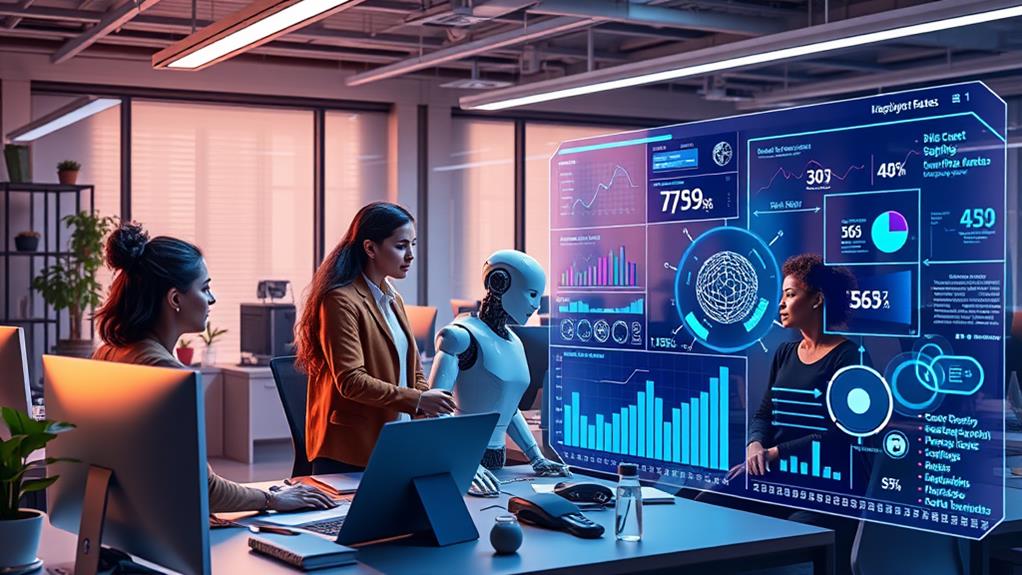Integrating AI into business automation can be like maneuvering through a maze—exciting but packed with obstacles. The skills gap is a significant hurdle; finding proficient talent can feel like hunting unicorns. Mixing human critical thinking with AI’s brute force is essential but often overlooked. Fear of job displacement looms large, spurring resistance. Strategic task selection is fundamental, avoiding the common pitfall of unnecessary automation. Add to that third-party integration woes, where even a tiny glitch can derail operations. Balancing these with the human touch in customer service is key. Stay tuned to master these challenges and supercharge your business!
Table of Contents
Key Takeaways
- Bridging the skills gap requires robust training programs and collaboration with educational institutions.
- Critical thinking integration is essential to avoid biases and inaccuracies in AI outcomes.
- Addressing job displacement fears through clear communication can enhance AI adoption and employee engagement.
- Strategic decision-making needs a balance of human insight and AI capabilities for effectiveness.
- Over-reliance on third-party AI integrations can introduce technical glitches and data security risks.
Bridging the Skills Gap

Bridging the skills gap is paramount for the successful adoption of AI in business automation. With 73% of US companies already harnessing AI, the demand for a skilled workforce is undeniable. Yet, many organizations grapple with a glaring shortage of expertise in AI development and maintenance. The solution? Robust training programs. These initiatives can demystify AI’s complexities, transforming bewildered employees into confident innovators.
Continuous learning is not just a buzzword; it’s a necessity. As AI technologies evolve at lightning speed, employees must perpetually update their skills to stay ahead. Imagine a workforce that embraces upskilling—a dynamic team ready to accelerate AI implementation and drive groundbreaking innovation. Sounds ideal, right?
But wait, there’s more! Collaborating with educational institutions can further bridge the talent gap. By promoting relevant AI skills among both current employees and fresh graduates, organizations can cultivate a pipeline of adept professionals ready to tackle AI challenges head-on.
In a nutshell, investing in training and fostering a culture of continuous learning isn’t just smart; it’s essential. Let’s empower our workforce and watch as they turn AI adoption into an extraordinary success story.
Addressing Job Displacement Fears
To effectively tackle the fear of job displacement due to AI, fostering a collaborative culture is essential.
Communicating the benefits of AI, such as how it enhances rather than replaces human capabilities, can turn anxiety into excitement.
Fostering Collaborative Culture
The specter of job displacement looms large in the minds of many employees when organizations introduce AI technologies. This fear can considerably hinder AI adoption, making it essential for companies to address these concerns proactively. A collaborative culture, where AI is viewed as an augmentation of human capabilities, can transform this fear into enthusiasm. By promoting employee involvement and emphasizing teamwork between AI systems and human workers, organizations can foster a supportive environment that encourages innovation.
| Challenge | Strategy | Outcome |
|---|---|---|
| Job Displacement Fears | Fostering Collaborative Culture | Enhanced Employee Engagement |
| Resistance to AI Adoption | Employee Involvement | Increased Adoption Rates |
| Skill Gaps | Training Programs | Empowered Workforce |
| Static Job Roles | Highlighting Human Capabilities | Enhanced Job Satisfaction |
Clear communication about AI’s benefits, such as increased efficiency and enriched job roles, is essential. Training programs that integrate AI into existing roles can alleviate fears, empowering employees to leverage these technologies effectively. When AI is presented as a tool to enhance rather than replace, workers are more likely to embrace it. This not only improves adoption rates but also nurtures a culture of continuous learning and innovation. Ultimately, by fostering a collaborative culture, organizations can transform potential obstacles into opportunities for growth and advancement.
Communicating AI Benefits
When organizations introduce AI technologies, addressing job displacement fears becomes paramount to ensuring successful adoption. Employee concerns can notably hinder AI implementation, with 73% of companies using AI reporting worries about job security.
To navigate this challenge, clear communication about the benefits of AI is vital. It’s not about replacing humans but augmenting their capabilities—think of AI as your new high-tech sidekick, not your replacement.
Highlighting increased efficiency and productivity can go a long way in easing these fears. Transparency is key: discuss openly how AI will streamline tasks, allowing employees to focus on more strategic, creative, and fulfilling work. This not only mitigates resistance but also paves the way for smoother AI adoption.
Moreover, fostering organizational collaboration by involving employees in the AI integration process can transform apprehension into enthusiasm. When team members feel included and heard, they are more likely to embrace change.
Addressing misconceptions head-on and showcasing real-world examples where AI has enhanced, not diminished, human roles can further bolster confidence.
In essence, prioritize employee concerns, maintain open lines of communication, and foster a collaborative culture to reveal the full potential of AI in business.
Human-AI Synergy
Human-AI synergy represents a transformative shift in the business landscape, requiring a strategic approach to address job displacement fears.
While the adoption of AI technology in business automation is skyrocketing, the fear of losing jobs can create significant resistance among employees.
But here’s the kicker: AI initiatives are not about replacing humans; they’re about enhancing human capabilities. Think Iron Man with his suit, not a robot takeover.
To foster a positive reception, consider these four strategies:
- Promote AI as a Tool for Augmentation: Emphasize how AI can take over mundane tasks, allowing employees to focus on more strategic and creative endeavors.
- Cultivate a Collaborative Culture: Open communication about AI benefits can increase employee involvement and make the shift smoother.
- Address Job Security Concerns: Inclusive discussions and education can alleviate fears and build trust in AI adoption.
- Invest in Reskilling Programs: Prepare your workforce for new opportunities by offering training that aligns with the evolving landscape of AI-driven roles.
Critical Thinking Necessity

Incorporating critical thinking into AI integration is more than just a smart move; it’s essential for blending human insight with automated processes.
Teams need to skillfully discern which tasks should remain human-driven to guarantee depth and detail in decision-making.
This balance allows organizations to harness AI’s power while making strategic decisions grounded in nuanced understanding.
Human Insight Integration
To truly leverage the potential of AI in business automation, integrating human insight becomes indispensable, as AI alone cannot emulate the nuanced judgment and strategic decision-making inherent to human critical thinking.
AI challenges often arise from its inability to address complex, context-specific problems without human intervention. While automation enhances efficiency, the necessity for training on AI integration cannot be overstated. Ensuring that human insight complements these automated systems is essential for achieving desired outcomes.
Consider this: around 85% of AI projects fail to meet expectations. Why? Often, it’s the lack of critical thinking and human oversight that derails these initiatives. Continuous monitoring and evaluation by humans are essential to identify biases and inaccuracies in AI-generated data, ensuring more reliable and fair outcomes.
Let’s break it down:
- Training: Equip your team with the skills to integrate AI effectively, marrying automation with human insight.
- Collaboration: Foster a culture where AI systems and human employees work hand-in-hand, driving innovation.
- Critical Thinking: Encourage critical thinking to address specific problems that AI alone cannot solve.
- Evaluation: Regularly assess AI outcomes to catch and correct biases and inaccuracies.
Incorporating human insight not only mitigates these challenges but also propels businesses toward truly transformative automation. By combining the efficiency of automation with the invaluable human touch, businesses can stay ahead of workplace automation trends and ensure that their processes are not only streamlined but also reflective of human understanding and empathy. This not only enhances the overall customer experience but also contributes to a more productive and positive work environment for employees. As workplace automation trends continue to evolve, the incorporation of human insight will become increasingly essential for businesses to remain competitive and relevant in the future.
Strategic Decision-Making
Steering the integration of human insight with AI automation brings us to the imperative of strategic decision-making and the necessity of critical thinking. While AI technologies can streamline countless business processes, the nuanced judgment required in complex scenarios remains a uniquely human skill.
In strategic planning, integrating critical thinking with AI models guarantees that decisions are not only data-driven but also contextually sound.
Implementing AI involves extensive data preparation, often consuming up to 80% of data scientists’ time. This highlights the critical need for thoughtful assessment and refinement of data to effectively train AI models.
Without critical thinking, the risk of inaccuracies and hallucinations in AI outcomes escalates, underscoring the importance of human oversight in validating these results.
Organizations that prioritize critical thinking training for their employees enhance their capacity to seamlessly integrate AI solutions, boosting productivity and fostering innovation.
Companies that embed a culture of critical thinking alongside AI adoption are better equipped to navigate the complexities of technology integration, thereby maintaining a competitive edge.
The bottom line? Critical thinking isn’t just a nice-to-have; it’s essential for strategic planning and effective AI implementation. Embrace it, and watch your business thrive.
Balancing AI Roles
Balancing the roles of AI and human essential thinkers is vital for organizations aiming to harness the full potential of automation. While AI systems can streamline processes and boost productivity, the necessity for critical thinking remains paramount.
Strategic decision-making and problem-solving are not entirely automatable; these tasks require a human touch, depth, and creativity. Organizations that invest in training their teams on AI integration can greatly enhance both productivity and efficiency.
Here’s why balancing AI-driven automation with human oversight is vital:
- Enhanced Productivity: Trained teams can leverage AI systems to handle routine tasks, freeing up human thinkers for more complex, strategic work.
- Critical Analysis: A study found that 85% of AI projects fail to deliver expected outcomes, often due to a lack of human oversight and critical analysis.
- Complex Problem-Solving: Employees can navigate intricate situations requiring emotional intelligence, a skill set beyond the reach of current AI systems.
- Continuous Monitoring: Regular evaluation of AI systems by humans can identify flaws and biases, ensuring improved effectiveness and reliability.
Task Automation Decisions
Steering task automation decisions in business automation is often a complex endeavor, given the rapid pace of technological evolution. Organizations are constantly challenged to identify which tasks can be automated effectively using AI without losing control or compromising on quality. The key is to pinpoint redundant and repetitive tasks—those tedious activities that make employees groan. By automating these, organizations can free up their workforce to focus on tasks that require human oversight and critical thinking.
However, employees frequently resist automation due to fears of job displacement and losing control over their work processes. This resistance underscores the importance of balancing automation with human involvement. Tasks requiring depth, detail, and emotional intelligence remain best suited for human execution. Trust me, no AI will ever replace a heartfelt conversation or a meticulous eye for detail.
A recent Gartner report highlights a sobering fact: 85% of AI projects fail to deliver expected outcomes. This statistic drives home the importance of careful task selection and management. Organizations must stay agile, leveraging the right technology to guarantee AI enhances rather than hinders their operations.
The future lies in smart automation decisions that empower employees and drive innovation.
Third-Party Integration Risks

Third-party integration risks pose a significant challenge for businesses leveraging AI for automation. Over-reliance on these integrations can introduce technical glitches that disrupt operations and tarnish customer experiences. Organizations need to be cautious, as dependence on third-party solutions can limit customization, making it difficult to adapt to unique business needs.
Integrating AI effectively requires a balanced approach.
Here are four critical points to reflect on:
- Data Security Risks: Third-party integrations can expose sensitive data to vulnerabilities. Organizations need rigorous security protocols to protect their information.
- Legacy Systems Compatibility: Outdated systems often struggle to integrate with modern AI solutions, leading to inefficiencies and operational hiccups.
- Flexibility Constraints: Relying on third-party AI can hinder an organization’s ability to tailor solutions, limiting innovation and responsiveness to market changes.
- Monitoring and Assessment: Continuous evaluation of third-party integration strategies is essential. Robust monitoring and assessment frameworks can identify potential issues early, ensuring peak performance.
Embracing these points can enhance resilience and minimize risks. Companies with diversified AI strategies are generally better positioned to navigate the complexities of third-party integration, ultimately driving innovation and efficiency.
Maintaining Human Empathy
Maintaining human empathy in AI-driven business automation is an essential aspect that businesses must address to guarantee customer satisfaction and loyalty. While AI tools can efficiently handle data and manage a high volume of customer inquiries, they often fall short in delivering genuine empathy.
Imagine calling customer service and getting a robotic response—frustrating, right? That’s why 70% of customers still prefer human interaction for complex issues.
To make sure that AI doesn’t strip away the human touch, companies need continuous monitoring and testing of AI interactions. After all, 47% of consumers feel that AI lacks the personal touch necessary in customer service.
It’s important to blend AI efficiency with human empathy. Research reveals that 61% of customers are more loyal to brands that provide empathetic service. So, balancing AI with occasional human oversight guarantees that customer experiences remain personalized.
Without human oversight, organizations risk losing the necessary empathetic engagement for effective customer retention—82% of consumers prioritize personalized experiences over automated responses.
Fundamentally, AI should enhance, not replace, the human touch. By harmonizing AI capabilities with human empathy, businesses can deliver stellar, personalized customer experiences that foster long-term loyalty.
Frequently Asked Questions
What Are the Issues With AI Automation?
AI automation faces issues including data privacy concerns, high implementation costs, skill gaps in the workforce, change resistance, integration complexity with legacy systems, and ethical considerations, all of which hinder seamless adoption and effective utilization.
What Is the Challenges of AI in Business?
AI in business faces significant challenges, including data privacy issues, ethical concerns, integration hurdles, workforce displacement, cost implications, and technological limitations. Addressing these complexities is essential for harnessing AI’s transformative potential in a competitive landscape.
What Is the Biggest Challenge Facing Ai?
The biggest challenge facing AI is balancing data privacy, ethical concerns, and bias mitigation while ensuring transparency. High implementation costs and workforce impact further complicate the adoption process, necessitating innovative approaches to overcome these multifaceted obstacles.
What Are Professional Challenges You Face Due to Artificial Intelligence and Digitalization?
Professional challenges due to artificial intelligence and digitalization include job displacement, skill gaps, ethical concerns, data privacy, decision transparency, and technology adaptation. Addressing these issues necessitates strategic planning and continuous learning to harness innovation while mitigating risks.
Conclusion
In summary, steering through the challenges of AI in business automation demands a multifaceted approach. Bridging the skills gap, addressing job displacement fears, and making thoughtful automation decisions are critical. Additionally, integrating third-party solutions and maintaining human empathy are necessary for a balanced implementation. Embracing these challenges equips businesses to harness AI’s potential effectively, driving innovation while respecting the human element. Success lies in thoughtful integration, continuous learning, and a commitment to ethical practices.






